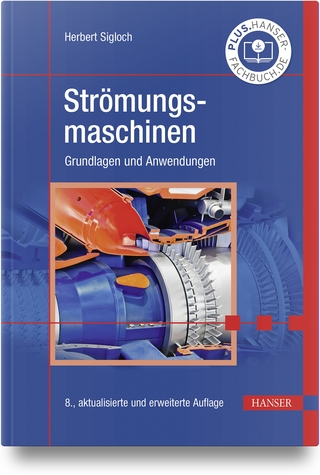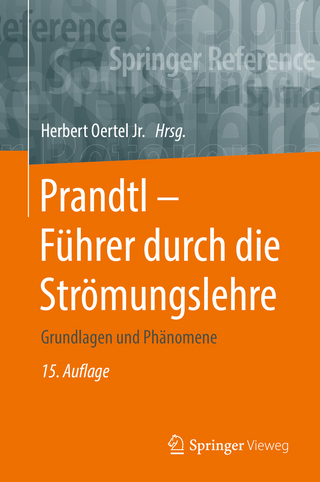
Transport and Coherent Structures in Wall Turbulence
ISTE Ltd and John Wiley & Sons Inc (Verlag)
978-1-84821-395-1 (ISBN)
- Lieferbar (Termin unbekannt)
- Versandkostenfrei innerhalb Deutschlands
- Auch auf Rechnung
- Verfügbarkeit in der Filiale vor Ort prüfen
- Artikel merken
Sedat TARDU is Associate Professor at Grenoble University in France where he teaches turbulent shear flows, heat transfer, fluid dynamics and chaos. His research area includes canonical and non-canonical wall turbulence, active and passive control of near-wall turbulence, unsteady wall layers, mixing and micro mixing and microfluidics. He has been a visiting researcher in several universities (Ecole Polytechnique Fédérale de Lausanne, Imperial College London, Beihang Un. Beijing). He is the author of more than 250 papers in peer-reviewed journals, and international conferences as well as several chapters in books.
Introduction xi
Main Notations xv
Chapter 1 General Points 1
1.1 Introduction 1
1.2 General equations 2
1.2.1 Eulerian relations 2
1.3 Notations 5
1.4 Reynolds equations 5
1.5 Exact relations in a fully developed turbulent channel flow 7
1.6 Equations for a turbulent boundary layer 12
1.7 Scales in a wall-bounded turbulent flow 14
1.8 Eddy viscosity closures 15
1.9 Turbulent intensities of the velocity components 32
1.10 Fine structure 38
1.11 Vorticity 42
1.11.1 Characteristics of vorticity field near to the wall 45
1.11.2 Turbulent intensities of the fluctuating vorticity components 52
Chapter 2. Transport Phenomena in Wall Turbulence 55
2.1 Introduction 55
2.2 Transport equations 56
2.3 Models of return to isotropy 63
2.4 Transport of turbulent kinetic energy 66
2.5 Transport of the velocity gradient 73
2.6 Transport of the Reynolds stress -uv 75
2.7 Effects of the Reynolds number on transport 77
2.8 Dissipation 82
2.8.1 Dissipation of kinetic energy 82
2.8.2 Dissipation linked to the transport equations for the Reynolds stresses 87
2.9 Pressure 92
2.9.1 Wall pressure 93
2.9.2 Spectral density 95
2.9.3 Decomposition into slow and rapid components 101
2.10 Anisotropy 113
2.11 Rapid distortion 121
Chapter 3 Near-wall Coherent Structures: History, Identification and Detection 129
3.1 Introduction 129
3.2 History 130
3.3 Single-point Eulerian detection 136
3.3.1 Detection in quadrant II 139
3.3.2 Detection by the u-level (u-l) 143
3.3.3 Detection by VITA and VISA 144
3.4 Stochastic estimation 148
3.5 Wavelets and wall turbulence 153
3.6 Critical points and topology 154
3.6.1 Critical points 154
3.6.2 Application of the concept of critical points to the topology of turbulence 157
3.6.3 Extension of the detection Q - Δ 165
3.6.4 A few significant results relating to the topology of wall turbulence 169
3.7 Pressure field and vortices 176
3.8 Vorticity and vortices 179
3.9 Transport of invariants 182
3.10 “Lambda-2” criterion 186
3.11. Relations between the topological invariants and the λ 2 technique 188
3.12 Summary 192
3.13 Lagrangian detection 194
Chapter 4. Coherent Wall Structures: Dynamics and Contribution to Turbulent Activity 199
4.1 Introduction 199
4.2 Structural morphology of wall turbulence Quasi-streamwise vortices or hairpin vortices? 200
4.3 Frequency distribution of energetic events in the inner sublayer 205
4.4 Quadrant-based structure of the Reynolds shear stress 212
4.5 Streaks 215
4.6 Wavelet analysis, at low Reynolds numbers, of the vorticity layers surrounding the streaks 221
4.7 Effect of coherent structures on local wall friction 226
4.8 Effect of coherent structures on wall pressure 234
4.9 Active and passive structures 235
4.10 Particle trajectories: Lagrangian approach 245
4.10.1 Lagrangian description and transport by turbulent diffusion 245
4.10.2 Lagrangian description of transport by energetic events 248
4.11 Dynamical systems approach 257
4.11.1 Karhunen–Loève series 258
4.11.2 POD and wall turbulence 259
4.11.3 Chaotic synchronization 264
Chapter 5. Regeneration and Self-maintaining of Coherent Structures 273
5.1 Introduction 273
5.2 Consensual structural elements 274
5.3 Conceptual models 275
5.3.1 Oseen vortex in a 2D mean shear 275
5.3.2 Synthetic wall turbulence 284
5.3.3 Viscous response of the flow to the convection of a vortex structure near to the wall 289
5.4 Generation of streaks and inner shear layers: simplified theoretical models 297
5.5 Elongated structures and streak formation 303
5.6 Regeneration of vortex structures Observations deduced from direct numerical simulations 305
5.7 Stability of streaks 317
5.7.1 Linear stability 317
5.7.2 Statistics in the inner layer 325
5.7.3 Transient growth and algebraic growth 326
5.7.4 Bypass transition 335
5.7.5 Transient growth and bypass transition of the streaks 342
5.7.6 Nonlinear transient growth 348
5.8 Instability of streaks, their repercussions and self-maintaining of structures 351
5.9 Triggering of the mechanism 358
5.10 Formation of arch vortices Generation of new streamwise structures 359
5.11 Discussion 360
5.12 A heuristic model 363
Chapter 6. Large- and Very Large-scale Structures 373
6.1 Introduction 373
6.2 Clusters of coherent structures 374
6.2.1 History 374
6.3 Characteristics of packets of structures at moderate Reynolds numbers 379
6.4 Kinematic consequences of coherent clustering of structures 381
6.5 Regeneration of the packets 389
6.6 Clustering of packets Very large-scale motions 394
6.7 Amplitude modulation by very large-scale motions 398
6.8 Dynamic role of very large-scale motions 410
Bibliography 423
Index 455
| Verlagsort | London |
|---|---|
| Sprache | englisch |
| Maße | 165 x 241 mm |
| Gewicht | 862 g |
| Themenwelt | Naturwissenschaften ► Physik / Astronomie ► Strömungsmechanik |
| Technik ► Bauwesen | |
| ISBN-10 | 1-84821-395-6 / 1848213956 |
| ISBN-13 | 978-1-84821-395-1 / 9781848213951 |
| Zustand | Neuware |
| Haben Sie eine Frage zum Produkt? |
aus dem Bereich


